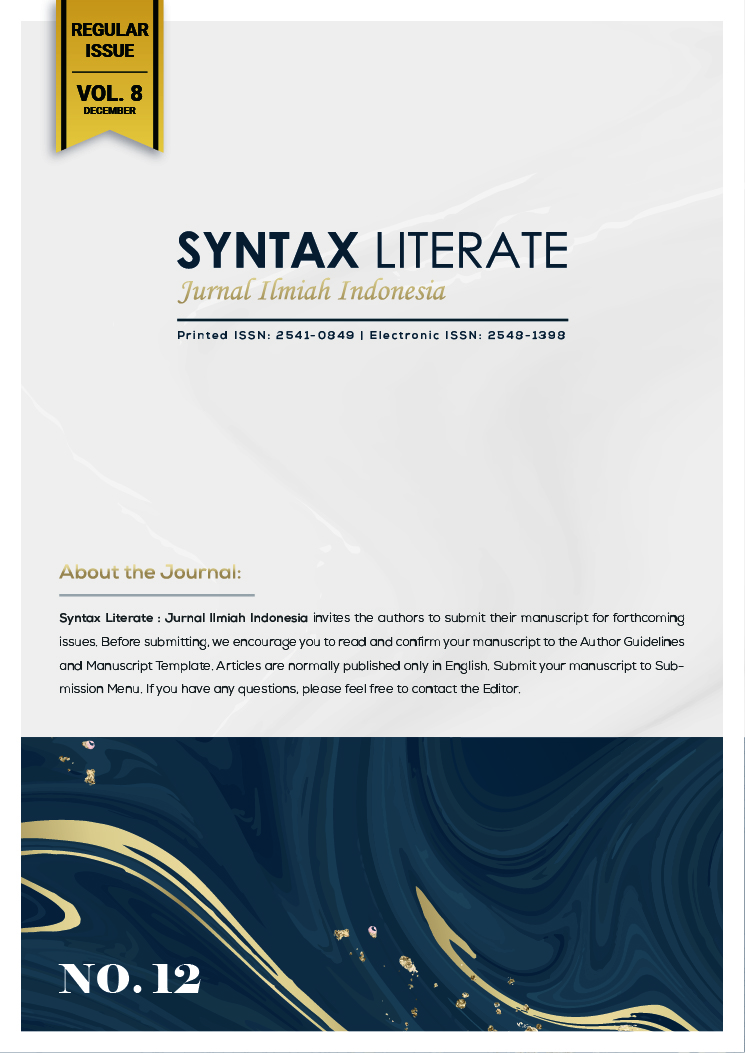Program Pengelolaan Penyakit Kronis Diabetes Mellitus sebagai Pencegahan Penyakit Degenerative Diabetes Mellitus, Dan Dampaknya Bagi Pekerja Di Indonesia
Abstract
The World Health Organization (WHO) estimates that the number of people with diabetes mellitus (DM) worldwide will increase rapidly to reach 21.3 million by 2030, an increase from 8.4 million in 2020. Workers are one of the groups most vulnerable to the risk of diabetes mellitus (DM). Almost all of the worker time is spent working indoors and doing only a few physical movements. This can lead to health problems. Due to the pressure brought on by their jobs, workers tend to engage in bad habits such as smoking, alcohol, and eating unhealthy foods, among others, which have an impact on their behavior and their lifestyle. The high level of stress experienced by para is the cause of this behavioural tendency. The impact of this behaviour makes workers vulnerable to diabetes mellitus (DM). Diabetes mellitus (DM) can appear suddenly without symptoms (silent killer). Workers must carry out health checks immediately to find out and prevent diseases such as diabetes mellitus (DM) early. Because Diabetes Mellitus tends to increase and begin to appear at a younger age of workers, companies must plan and optimize the management of screening examinations early for workers to detect the incidence of Diabetes Mellitus through occupational health activities, especially by involving all workers so that the risk of Diabetes Mellitus events with risk factors that already exist in each worker can be predicted early through The Chronic Disease Management Program (PROLANIS) has a positive impact in managing type 2 Diabetes Mellitus (DM) in the prevention of degenerative diseases in Indonesia. However, there are still several obstacles, such as inappropriate schedules, lack of public awareness, and the need for role models and peer group support in running this program. Therefore, efforts to optimize the PROLANIS DM program and increase the understanding of participants and the public about the importance of DM prevention are very important to overcome this problem and its impact on Indonesian workers in the prevention of degenerative NCDs that can prevent productive age.
Downloads
References
Cahyo Kristianto, F., Sari, D. L., & Kirtishanti, A. (CoMPHI Journal: Community Medicine and Public Health of Indonesia Journal). Pengaruh Program Penanggulangan Penyakit Kronis (PROLANIS) terhadap Kadar Gula Darah Pasien Diabetes Melitus Tipe 2.
Dianingsih, et al. (2022). Strategi Optimalisasi Pelaksanaan PRB Pasien DM peserta BPJS Kesehatan di Puskesmas. Jurnal Manajemen Pelayanan Kesehatan.
Endokrinologi Indonesia. (2021). Pedoman Pengelolaan dan Pencegahan Diabetes Melitus Tipe 2 Dewasa di Indonesia-2021. Perkeni.
Estimasi Biaya Langsung Medis Penderita Rawat Jalan Diabetes Mellitus Tipe A, RSUD Abdul Aziz Singkawang. (2013). Estimasi Biaya Medis Rawat Jalan DM Tipe 2 Mursalin & Soewondo.
Fatimah, R. N. (Vol. 4). Restyana Noor F|Diabetes Melitus Tipe 2 DIABETES MELITUS TIPE 2. J MAJORITY.
Gultom, E. I., Afriandi, I., & Gondodiputro, S. (Jurnal Kebijakan Kesehatan Indonesia : JKKI). Perbedaan Utilitas Pasien Dm Di Fasilitas Kesehatan Tingkat Pertama Sebelum Dan Sesudah Penerapan Kebijakan Kapitasi Berbasis Kinerja (Kbk) Di Kota Cimahi (Analisis Data Sampel BPJS 2015-2020).
Irawan, D. (2007). Universitas Indonesia Prevalensi dan Faktor Risiko Kejadian Diabetes Melitus Tipe 2 di Daerah Urban Indonesia (Analisa Data Sekunder Riskesdas 2007).
Juwita, N. E., & Santoso, D. (Jurnal Jaminan Kesehatan Nasional (JJKN)). Tantangan Pelaksanaan Skrining Riwayat Kesehatan Peserta JKN-KIS dengan Pendekatan Stakeholder Engagement.
Ketut Suastika, et al. (2021). Pedoman Pengelolaan Dan Pencegahan Diabetes Melitus Tipe 2 Dewasa di Indonesia-2021. Perkeni.
Kholid Faisal. (2020). Perbandingan efektifitas senam prolanis dan dm terhadap gula darah penderita dm. Comprehenship nursing journal.
Maharani. (2018). Analysis of Impelentation of the Chronic Disease Management Program (PROLANIS) DM tipe II during covid 19. Journal of Indonesian Health Policy.
Muthoharun, A. (2023). Efektifitas Senam Prolanis Terhadap Kadar Gula Pasien DM. Pengembangan Ilmu dan Praktek Kesehatan.
Novera Rita. (2020). Analisis Perbandingan Biaya Dengan Tarif Paket INA CBG’s dan efektifitas biaya berdasarkan nilai ICER DM tipe II rawat inap di RSUD Bandung.
Puspita, N., & Khairunnida, K. (2022). Efektivitas Edukasi Obat untuk Pasien Diabetes Mellitus pada Masa Pandemi Covid-19 di Puskesmas Kecamatan Cempaka Putih, Jakarta Pusat. Jurnal Sains dan Kesehatan.
Prabowo, et al. (2022). Peningkatan Pengetahuan dan Kualitas Hidup Pasien DM di RS UNS. SSEJ.
Refyaldiza Ridwan, F., Heryaman, H., & Kusumawati, M. (JSK). Kesadaran Masyarakat untuk Melakukan Penapisan Diabetes Melitus Tipe 2 di Desa Cilayung dan Desa Cipacing Kecamatan Jatinangor.
Tonang Dwi Ardyanto. (Jurnal UNISA). Peningkatan pengetahuan dan kualitas hidup pasien DM di RS UNS.
Ulfa Khairatul. (2019). Efektivitas Senam Prolanis Terhadap Penurunan Tekanan Darah dan Kadar Gula darah Di puskesmas. ABULYATAMA.
Wahidin, M., Kurniawan, A., & Agita, S. (Buletin Penelitian Kesehatan). Penyelenggaraan Pembiayaan Non Kapitasi Untuk Penapisan Faktor Risiko Penyakit Tidak Menular di Kota Bogor, Jawa Barat.
Copyright (c) 2023 Dicky Permana Putra, Anita Rahmiwati, Yuanita Windusari, Novrikasari, Nur Alam Fajar

This work is licensed under a Creative Commons Attribution-ShareAlike 4.0 International License.











